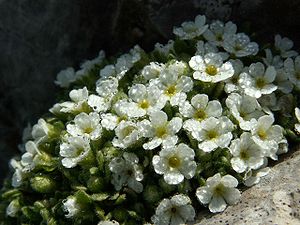Swiss man shield
| Swiss man shield | ||||||||||||
|---|---|---|---|---|---|---|---|---|---|---|---|---|

Swiss man's shield ( Androsace helvetica ) |
||||||||||||
| Systematics | ||||||||||||
|
||||||||||||
| Scientific name | ||||||||||||
| Androsace helvetica | ||||||||||||
| ( L. ) All. |
The Swiss man's shield ( Androsace helvetica ) is a species of the primrose family (Primulaceae). This lime-loving species is one of the most typical rock plants in the Alps.
features
The Swiss man shield grows as a low cushion plant and reaches heights of 1–3 cm. It usually has white flowers and can be fertilized both by insects (especially flies) and by self-pollination. The small seeds are spread by the wind and are frost germs .
Using a deep penetrating into crevices taproot is the Swiss Mannsschild able to withstand even on highly weather-exposed areas. The small, hairy, roof-tile-like leaves and its hemispherical shape also offer protection from the elements. These plant pads can reach a diameter of up to 15 cm and an age of 50 to 60 years. In the course of growth, individual leaflets repeatedly die and are replaced by new ones. The dead leaves become humus and the interior of the hemisphere, with its cavities created by the putrefaction, resembles a sponge that can absorb enough water so that the Swiss man shield can survive longer periods of drought.
The flowering period extends from May to July.
The species has chromosome number 2n = 40.
Occurrence
The Swiss man's shield can be found in the Northern Rim Alps, rarely in the Inner Alps and somewhat more frequently in parts of the Southern Rim Alps. The Swiss Mannsschild thrives on limestone rock at altitudes between 1500 and 3700 meters (alpine to nival ). In the Allgäu Alps, it rises from 1580 m in the Tyrolean part between the Middle and Upper High Alps up to 2650 m above sea level at the summit of the Mädelegabel .
In Austria it can be found scattered in the federal states of Upper Austria , Styria , Salzburg , Tyrol and Vorarlberg .
Locations and distribution in Central Europe
The Swiss Mannsschild needs chalky subsoil. It is a character species of Androsacetum helveticae from the association Potentillion caulescentis.
It mainly colonizes fine rock crevices, preferably on sunny southern slopes, but it also goes into coarse rubble. He endures great temperature differences. It thrives between 1800 and 3000 m, it rarely goes deeper or higher.
In the Northern Limestone Alps it occurs scattered and becomes rarer towards the east, in Austria it is absent in certain areas. It is rare in the Southern Limestone Alps and the Central Alps.
literature
- Xaver Finkenzeller: Alpine flowers. Recognize & determine. Mosaik, Munich 2002, ISBN 3-576-11482-3 .
- Dietmar Aichele, Heinz-Werner Schwegler: The flowering plants of Central Europe , Franckh-Kosmos-Verlag, 2nd revised edition 1994, 2000, Volume 3, ISBN 3 440-08048-X
Individual evidence
- ↑ a b Erich Oberdorfer : Plant-sociological excursion flora for Germany and neighboring areas . 8th edition. Stuttgart, Verlag Eugen Ulmer, 2001. ISBN 3-8001-3131-5
- ↑ Erhard Dörr, Wolfgang Lippert : Flora of the Allgäu and its surroundings. Volume 2, IHW, Eching 2004, ISBN 3-930167-61-1 .
Web links
- Swiss man shield. In: FloraWeb.de.
- Swiss man shield . In: BiolFlor, the database of biological-ecological characteristics of the flora of Germany.
- Androsace helvetica (L.) All. In: Info Flora , the national data and information center for Swiss flora . Retrieved January 16, 2016.
- Thomas Meyer: Mannsschild data sheet with identification key and photos at Flora-de: Flora von Deutschland (old name of the website: Flowers in Swabia )
